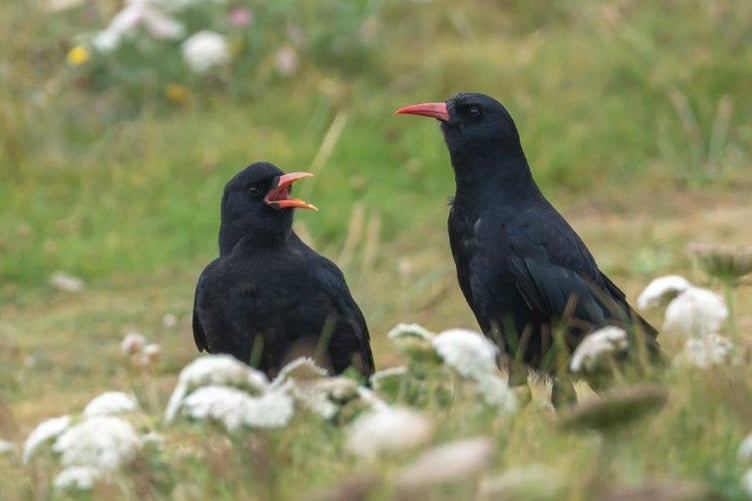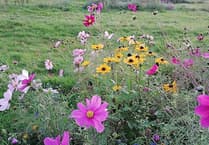THE Cornish Chough has become a conservation success story after more than 100 Choughlets were added to their population in 2025 for the third year in succession.
Forty eight of the confirmed breeding pairs were successful in raising a brood, up from last year’s total of 42. From those nests, 129 young Choughs emerged 15 more than in the 2024 breeding season.
Three of these nests produced five fledglings each, which is the highest number of fledglings recorded for a single nest to date. This is also the first year that the project has recorded as many as three nests producing five fledglings each.
There were 39 successful breeding pairs in 2023, raising 112 young and in 2022 there were 25 successful pairs, raising 71 young.
Hilary Mitchell from Cornwall Birds (CBWPS), said: “2025 marked yet another incredibly productive breeding season for our Cornish Chough and is the third year in a row that more than 100 chicks have fledged. No one back in 2001, when three Chough arrived on The Lizard from Ireland, would have imagined this level of success was even possible.
“Sadly, we lost the pioneering Lizard pair in 2013. They had been incredibly productive, having fledged a grand total of 46 chicks in their lifetime. Volunteers who had devoted many hours to monitoring them and keeping them safe were devastated. The future of the Cornish Chough looked at risk with the loss of such an iconic and productive pair.
“In 2025, one of their daughters, now 16 years old and living in the far west, surpassed her parents’ record. In total, she has now fledged 48 chicks, many of whom have survived to produce Choughlets of their own. She’s had two different mates, losing her first in 2014, and she has been paired with her current male since then.”
In recent years, the fortunes of the Cornish Chough have been transformed. From a recovery that was precariously balanced in 2013, the number of successful breeding pairs has increased from five in 2013 to nearly 50 in 2025. Fourteen chicks fledged in 2013, compared to just short of 130 in 2025, which is about 10 times more pairs and Choughlets in 12 years.
Hilary Mitchell said: “As always, we would like to thank everyone who has helped us keep track of our Chough by reporting their sightings. We really appreciate people telling us where to find new pairs, or even just confirming for volunteers that ‘their’ pair is alive and well. It’s lovely to hear that people have found their very first Cornish Chough too.”
Teeanna Cleary-Skelton, the Chough conservation officer for the RSPB in Cornwall, added: “When talking about the Cornish Chough, the same sentiment is repeatedly expressed: what an incredible success story it is, especially in a field where this can be seriously lacking.
“For example, 2025 marks the 20th birthday of a male chough that was fledged from the nest of the original Lizard pair, who made their way to Cornwall all the way back in 2001. This is the oldest Cornish Chough recorded. He has now been responsible for almost 20 years of productivity and is one of the three pairs this year who managed to successfully fledge five Choughlets.
“Pick a stretch of Cornish coastline and visitors stand a very good chance of seeing a large flock of young, non-breeding Choughs. As they mature and settle on nest sites of their own, it is hoped that more of the population will expand their range along the coastline. Particularly the north coast, where the project has focused their surveying efforts this year, thanks to an overwhelming response to a call for volunteers last year.”
James Burges, Chough surveyor for the RSPB in Cornwall, said: “It has been a real privilege and good exercise to follow the ups and downs, sometimes literally, of a pair of Choughs on my local patch of coast.
“Initial excitement of hearing of sightings around Tintagel and then a fellow volunteer identifying an early nesting attempt was followed by disappointment when this was sadly unsuccessful. However, 'Arthur and Guinevere' stuck around, and since then I have been following them as they have been exploring the cliffs and valleys. Hopefully next year, they will attempt to breed here again.”
Choughs were extinct in Cornwall 50 years ago and it has taken decades of close partnership work to reach the current positive position. The conservation expertise of the RSPB, the passion of Cornish nature-friendly farmers and land managers who have brought back grazing to the cliffs, vital funding for this land management from Natural England, the coordination and cooperation of conservation organisations like National Trust, and the dedication of volunteers who monitor the birds, plus those who report the valuable sightings to Cornish Birds (CWBPS), have all combined to make this a conservation success story.
Paul St Pierre, Conservation Officer for the RSPB in Cornwall, said: “The recovery of the Chough population is an amazing conservation success story, and we are particularly excited about its spread along the north coast, where it can ultimately link up with the Welsh population. However, with uncertainties regarding government schemes to support coastal management and increasing recreational pressures, this is not assured.”
Steve Sudworth, Lead Ranger for Godrevy to St Agnes National Trust, said: “One of the central aims of our new strategy is to restore nature and it’s fantastic to see this happening with Chough in Cornwall. Since 2022, the number of Chough fledged has increased year on year from Godrevy to St Agnes and their charismatic ‘chee-ow’ call is now regularly heard along our stretch of coast. With their population in Cornwall doing so well, will they now start to spread further inland or further around the coast? We’ll look forward to finding out.”
Anyone who sees Choughs in Cornwall can email their sightings [email protected]

.jpg?width=209&height=140&crop=209:145,smart&quality=75)



Comments
This article has no comments yet. Be the first to leave a comment.